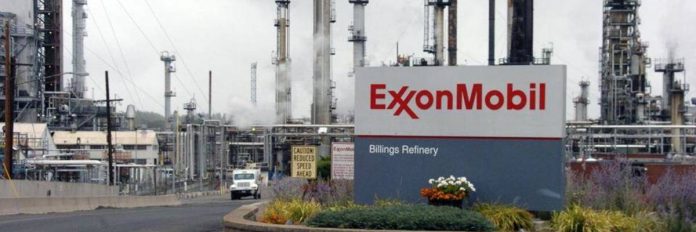ExxonMobil Corporation has attributed decline in its first quarter earnings to weak industry fuels margins from high gasoline inventory levels and narrowed North American crude differentials. The company’s earnings fell by nearly 50 percent when compared to the first quarter of 2018.
The company announced an estimated first quarter earnings of $2.4 billion, or $0.55 per share assuming dilution, compared with $4.7 billion a year earlier. ExxonMobil reported a quarterly loss in its downstream business, which focuses on refining oil into fuels like gasoline and diesel. The company said brimming stockpiles of gasoline led to weak fuel margins during the quarter. It also continued a heavy slate of refinery maintenance.
But Darren W. Woods, chairman and chief executive officer, ExxonMobil, said solid operating performance in the first quarter helped mitigate the impact of challenging downstream and chemical margin environments. “We continued to benefit from our integrated business model. We are making strong progress on our growth plans and expect to deliver sustained value for our shareholders. The change in Canadian crude differentials, as well as heavy scheduled maintenance, similar to the fourth quarter of 2018, affected our quarterly results,” he said.
The report showed cash flow from operations and asset sales was $8.4 billion, including proceeds associated with asset sales of $107 million. During the quarter, the company distributed $3.5 billion in dividends to shareholders. Capital and exploration expenditures were $6.9 billion, up 42 percent from the prior year, reflecting key investments in the U.S. Permian Basin.
Oil-equivalent production was four million barrels per day, up two percent from the first quarter of 2018. Excluding entitlement effects and divestments, oil-equivalent production was up three percent from the first quarter of 2018. Upstream liquids production grew by five percent compared with the first quarter of 2018, driven by Permian unconventional growth of nearly 140 percent.
In the upstream, the report showed that crude oil prices strengthened during the quarter but remained weaker, on average, than the fourth quarter of 2018. It indicated that North American differentials narrowed, largely as a result of imposed production curtailments in Canada and additional takeaway capacity in the Permian.
“Natural gas prices were impacted by warmer weather. Production volumes benefited from continued unconventional growth. However, first quarter production was negatively impacted by lower Kearl output in Canada and downtime.”
Likewise, in the downstream, ExxonMobil achieved first sales of on-specification Group II basestocks from the advanced hydrocracker at the Rotterdam refinery in the Netherlands. The new unit uses proprietary catalyst in a unique refining configuration to upgrade lower-value vacuum gas oil into higher-value EHC™ Group II basestocks and ultra-low sulfur diesel.
“Weak industry fuels margins from high gasoline inventory levels and narrowed North American crude differentials impacted results in the quarter. Overall heavy scheduled maintenance remained at similar levels to the fourth quarter of 2018. Sales volumes increased from the prior year quarter reflecting project growth; however, margins remained challenged with continued supply length from recent industry capacity additions.”
ExxonMobil made two additional discoveries offshore Guyana at the Tilapia-1 and Haimara-1 wells during the first quarter. In April, the company also announced a new discovery at the Yellowtail-1 well, marking the 13th discovery on the Stabroek Block. The company made a natural gas discovery offshore Cyprus in the Eastern Mediterranean at the Glaucus-1 well. Based on preliminary interpretation of the well data, the discovery could represent an in-place natural gas resource of approximately 5 trillion to 8 trillion cubic feet (142 billion to 227 billion cubic meters). Further analysis is required to better determine the resource potential.
It also revised its Permian Basin growth plans to produce more than 1 million oil-equivalent barrels per day by as early as 2024. The size of the company’s resource base in the Permian is approximately 10 billion oil-equivalent barrels and is likely to grow further as analysis and development activities continue.
According to the report, ExxonMobil and partner Qatar Petroleum made a final investment decision to proceed with development of the Golden Pass LNG export project located in Sabine Pass, Texas. The facility is expected to start up in 2024. The project will have capacity to produce approximately 16 million tons of liquefied natural gas per year and provide an increased, reliable, long-term supply of liquefied natural gas to global gas markets.
“ExxonMobil reached a final investment decision and started construction on a new unit at its Beaumont, Texas refinery that will increase crude refining capacity by more than 65 percent, or 250,000 barrels per day. The third crude unit within the facility’s existing footprint will expand light crude oil refining and be supported by increased crude oil production in the Permian Basin.
“ExxonMobil reached a final investment decision on construction of a new polypropylene production unit in Baton Rouge, Louisiana that will expand production capacity along the Gulf Coast by up to 450,000 metric tons per year. Construction will begin in 2019 and startup is anticipated by 2021.”


